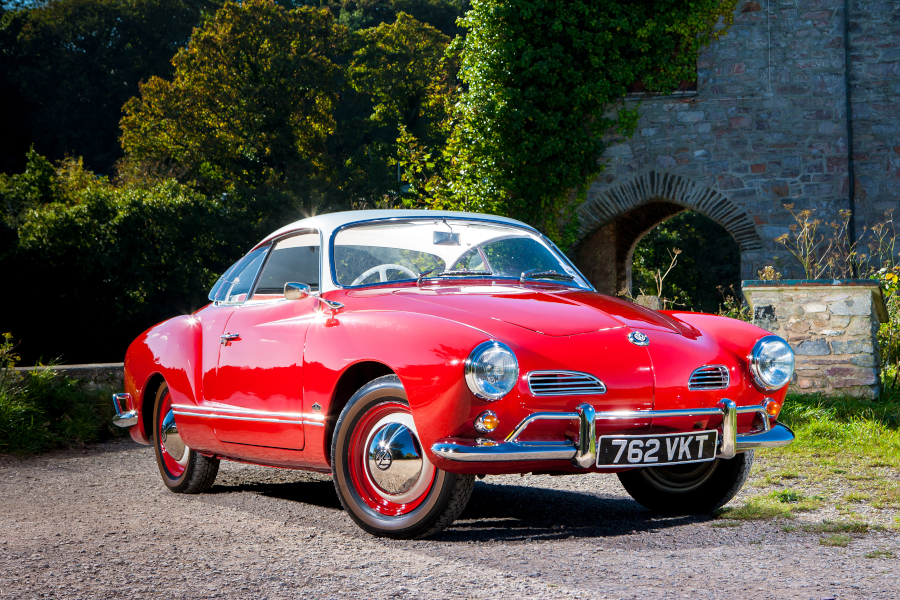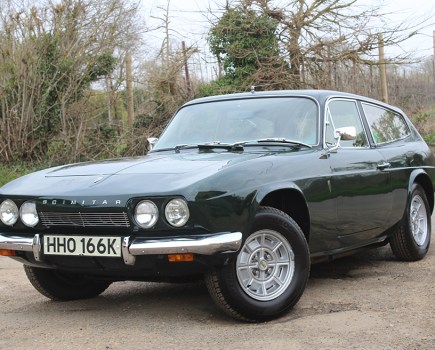Exotic looks clothed nothing more exotic than Beetle running gear, but the stylish Karmann Ghia is a highlight of the air-cooled VW scene
Images: Jon Robinson-Pratt
In the context of today’s automotive market, the idea of creating a stylish-looking sports car without the performance to match its exotic looks doesn’t seem that unreasonable – as witnessed by the number of two-wheel drive faux-4x4s crowding our roads.
It was no doubt the thinking which also encouraged 1950s VW chief Heinz Nordhoff to commission Torinese styling house Ghia to work up a coupe version of the humble VW Beetle.
Ghia had worked with VW before and it’s commonly accepted that the resulting Karmann Ghia was the work of boss Luigi Segre but as David Burgess-Wise pointed out in his 1985 work Ghia: Ford’s Carrozzeria, that’s not the whole truth. Ghia had become a popular choice for larger car makers wanting to turn styling models into full-size show cars and in 1952 had built the K-310 show car styled by Chrysler’s Virgil Exner. A brief glance shows the VW to be very much a scaled-down version of the K-310.
Ghia’s small size prevented it from producing the car it had designed, production being handled back in Germany by Karmann which was able to handle the 40,000-odd annual quantities required. This would be a significant move for Karmann, which also produced the Beetle Cabriolet for Volkswagen and would go on to produce the open Golf as well as the Corrado before eventually becoming a VW Group subsidiary in 2009.
Despite the relatively high production volumes, the Karmann Ghia involved a large proportion of hand finishing, notably plenty of lead loading around the elegant curves and body seams. The elegant bodyshell sat on what was for most purposes a standard Beetle floorpan chassis, retaining the central tunnel ‘spine’ but with floorpan sections widened by 4.6 inches. Production involved complete rolling chassis being supplied from the Volkswagen production lines to the Karmann works where the bodies were assembled and fitted.
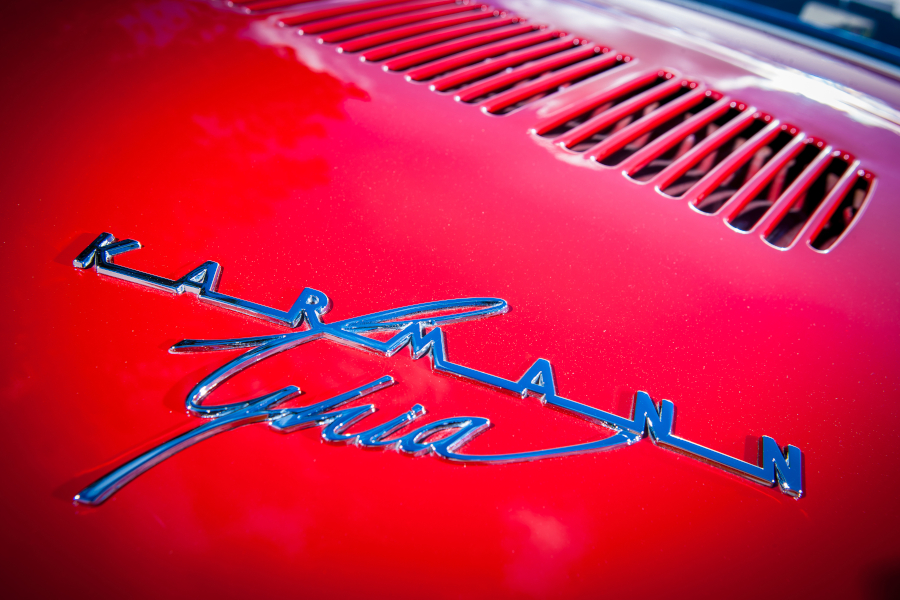
Motive power was provided by a standard air-cooled flat-four engine plucked from the Volkswagen Beetle which grew over the years from the original, 1192cc to 1584cc but which never offered more than 50bhp.
Despite this, the Karmann Ghia sold well, notably in the USA where some clever marketing played on its combination of exotic looks and reliable underpinnings. In later life it would become a favourite of the VW custom scene too.
The Karmann Ghia was launched in 1955 as a 2+2 coupe using the 1192cc, 34bhp Beetle engine and in September 1957 the stylish convertible was added to the range. This was engineered solely by Karmann without Ghia being involved and the removal of the roof involved no changes to the sheet metal below the beltline.
In 1959 the headlights were relocated higher in the reshaped front wings and the simple intake ducts replaced by chromed grilles, while inside a padded dash was fitted. The pre-’59 cars these days are known as the ‘Lowlight’ model.
In 1960, the 1200 motor was uprated to 40bhp, in 1961 the front VW badge was revised and in 1965 the car gained the 1285cc engine from the Beetle 1300 model, together with modern balljoint front suspension replacing the old kingpin design.
In 1966, the 1500 engine was fitted, alongside a widened track, front disc brakes, dual-circuit brakes, 12-volt electrics and four-bolt wheels. The rear suspension torsion bars gained softer spring rates, while a camber compensator bar aimed to reduce the positive camber of the rear wheels when unloaded under braking.
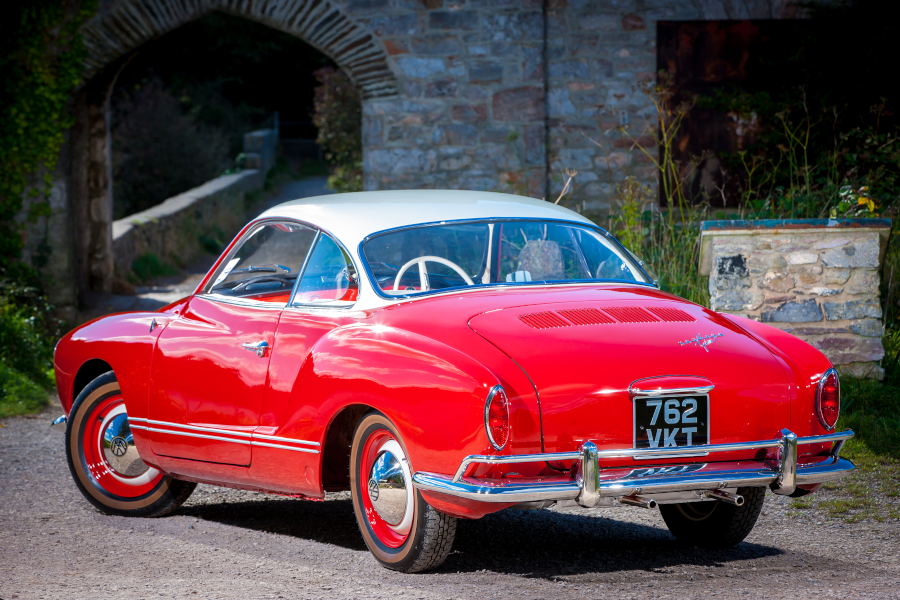
In 1967 the fuel filler was moved from under the front lid to the offside front wing, but the big news was the optional semi-automatic transmission, using a three-speed torque converter automatic with a vacuum-operated clutch actuated by a micro-switch under the gearknob. The system also came with a new double-jointed independent rear suspension. Replacing the simple swing-arm set-up, it vastly improved the handling by virtue of reducing the camber change of the rear wheels under accelerating and braking and from 1968 was made available with the manual gearbox too.
In 1969, larger indicators were fitted, while the Karmann Ghia also gained the 50bhp 1584cc engine. In 1971 the chunky rear lamps from the Type 3 were fitted, while inside the dashboard and door caps were covered in stippled black plastic and the instrument cluster was redesigned to use the dials from the Type 3. A stronger front bumper was fitted from 1972 and from 1973 the channel-section ‘Europa’ bumpers were fitted as well as an alternator. In December of the same year, production for the European market ended, although it continued until June 1974 for US export sales.
Since the Karmann Ghia was produced away from the constraints of the regular production line in Wolfsburg, detail changes were many and some features lasted for just a single production year.
Clearly, buying a Karmann Ghia requires that you really know your stuff, which is why we spoke to Russ Weir at specialist Californian Classics in East Sussex. The staff here live and breathe Karmann Ghias and supply parts for the cars as well as restoring them so there’s nothing they don’t know.
Bodywork
It was while photographing a BMW 6-Series for a BMW magazine that I first heard the joke “What’s the German for rust..? Karmann!” and it’s an unfortunate truth that most of the cars manufactured by the Osnäbruck firm have gained an unfortunate reputation for rot.
The Ghia is no different: as Russ advises, the bottom six inches of the vehicle will all need close attention and these days it’s not just to check for rot but to check for any iffy repairs. After all, the youngest of these cars is over 45 years old now and few of them will have escaped at least some restoration work.
The KG’s construction is very similar to the Beetle, which means you’ll want to check the body sills and heater channels (hot air from the engine is ducted through the sills to the interior) as well as the inner wings, especially where they meet the heater channels at the bottom of the A-pillar.
The bottom edges of the wings can also rot but here there’s a crucial difference from the Beetle, with its simple bolt-on wings: the entire front end of the Ghia was welded together at Karmann, with the seams lead loaded by hand.
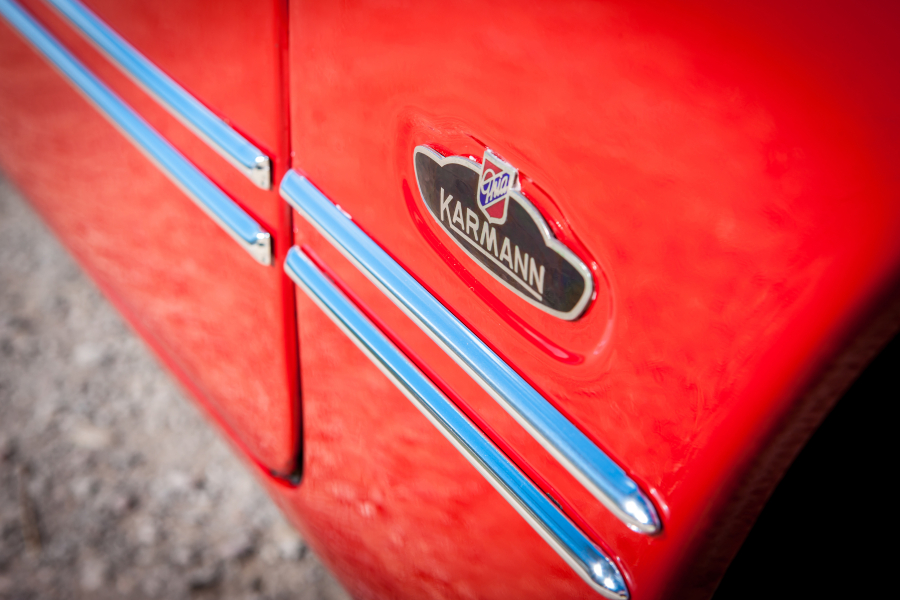
This means that any serious restoration work will involve major surgery: the front end panels will need to be cut off in order to gain access to make repairs behind it, such as repairs to the air intake boxes behind the intake grilles which are a common rot spot. Similarly, repairs to the outer sills or heater channels will involve the wings being cut off.
Good news? Well at least you can get the panels to repair the sill and heater channel area and repair panels are also available for the nose cone, but none of the opening panels – doors, front lid or engine cover – are available, so repairing the existing panels is the only option. Door skins are available but they’re universal panels carrying the indent for the later trigger-type door handles so will need altering to suit the different style of the pushbutton handles on early cars.
When a NoS front wings do come up, it’s not uncommon to see them sell for £1500 a side but repair panels are available. Naturally, parts for the pre-’59 Lowlight models are even harder to find.
The Ghia is built on the same rolling floorpan chassis as the Beetle, but with the extra width added in the floors, essentially by fitting the wider floor panels from the VW Type 181 military vehicle, a latter-day Kübelwagen briefly marketed in the UK as the Trekker.
This means that the floors kick out more sharply behind the wheels than the Beetle and they’re noticeably a different shape, but in recent years the correct floors have become available, negating the need to modify Beetle parts.
Suspension, steering and brakes
As for the rest of the running gear, it’s essentially Beetle componentry, meaning parts and expertise are freely available. The early cars with the kingpin front suspension need regular greasing, so it’s worth a look to see if the nipples on the front beam have seen a grease gun in living memory, while many cars will have been fitted with a lowered or adjustable front suspension. This generally involves cutting the tubes and welding in an adjuster which is used to change the preload of the torsion bar spring leaves inside the tube, so check that it’s been done properly.
Similarly, the rear end is often lowered, although this is done simply by rotating the suspension arms on the splines of the torsion bars.
The brakes are entirely conventional and shared with the Beetle. The disc system is nice to have, although the earlier all-drum system works surprisingly well if it’s properly adjusted. Any problems will be easily dealt with, such as seized callipers or leaking wheel cylinders and parts are cheap and easily obtained.
Engine and transmission
The engines in the Karmann Ghia are all essentially Beetle units and as such are reliable when kept in standard form and properly maintained. Sadly, all too often owners neglect the basic maintenance in favour of ill-advised customising, with predictable results.
Heat is the enemy of the air-cooled engine and the oil system plays a big part in controlling temperature, as well as the cooling fan. If the oil level isn’t up to scratch, suspect an uncaring owner, while any missing items of ‘tinware’ in the engine compartment are bad news too. What you see inside the engine bay is only a small part of the engine, as the cylinders, sump and crankcase are largely hidden underneath. The design takes in cool air from above which is ducted from the cooling fan over the hot cylinders below, with the matt black metal pressings designed to seal the aperture around the engine and separate the hot and cold air. If it’s been removed, the engine won’t be properly cooled and shiny chromed parts won’t suppress the heat as well as the factory’s satin black parts either.
If a VW flat-four engine puffs a touch of blue oil smoke on first starting after being stood overnight, especially if it was shut down after a long run, then don’t worry. The design of all horizontally-opposed engines means a dribble of hot oil can seep into the cylinders via any open valves and it will blow away on starting.
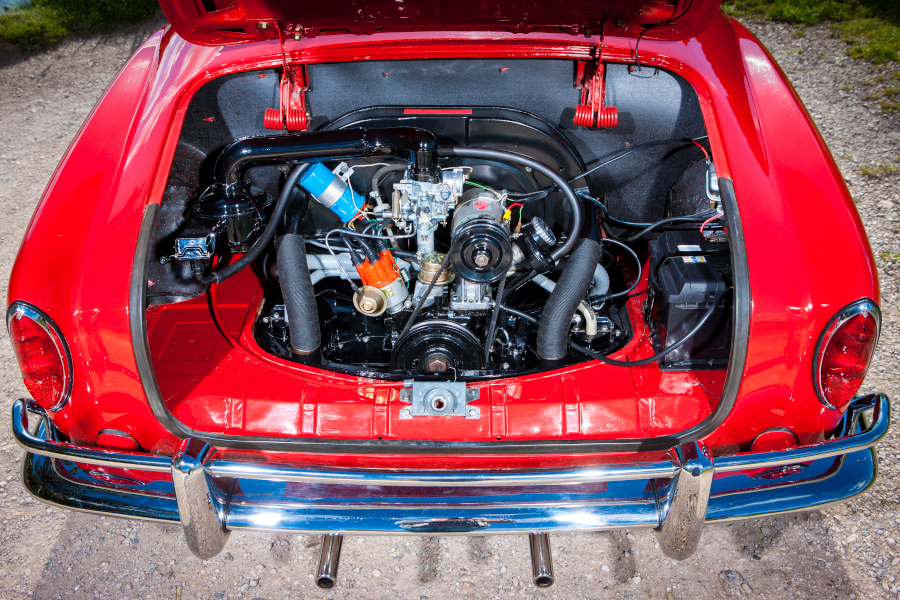
In good health the VW engine should sound like a well-oiled sewing machine, with any clattering suggesting valve clearances which need attention. If the worst happens though, it’s one of the simplest engines to remove: just lift the car, unbolt the engine from the gearbox and slide it out.
The VW transaxle gearbox is notoriously tough and it’s rare to find one with major problems. Jumping out of gear, especially when coming off the throttle quickly, can often mean the linkage needs adjusting – a simple job involving slackening the plate at the base of the lever.
You’ll sometimes come across a car with a noisy diff, but they can get noisy and then carry on happily for years.
A very vague shift action or a rattling from the lever can often be down to a worn nylon block in the long shift rod. It’s a simple DIY job, accessed via a plate under the back seat.
Any clutch problems needn’t be too much of a worry given how easy it is to remove the engine on air-cooled VWs. Simple adjustment is performed via a wing nut on the end of the cable.
Interior and trim
The uninformed will assume the Karmann Ghia’s cabin is furnished with Beetle componentry but nothing could be further from the truth. Apart from certain switchgear and detail parts, virtually nothing is shared with the Beetle: the seats use differently spaced runners and never moved to the three-point runners, so Beetle seats simply don’t fit while door cards, headlining and carpet are of course entirely different.
Specialists can supply seat foams though, while a trimmer can sort out tired covers and Newton Commercial can supply carpet sets in the correct style for both coupe and convertible.

Karmann Ghia: our verdict
The Karmann Ghia is a car of contradictions: on the one hand, its pedestrian performance doesn’t live up to its flamboyant looks but on the other hand it’s an eminently sensible combination of no-nonsense, easily maintained Beetle running gear and exotic styling.
As a classic today, the 1200-engined ‘lowlight’ cars are perhaps best left to diehard air-cooled VW fans, but the 1500 and 1600-powered models have the pace to keep up with modern traffic and the Karmann Ghia will always turn heads at any car event.
Just make sure you buy on condition and avoid the costly rust issues. It’s also worth double checking that you’re not unwittingly buying a left to right-hand drive converted car.
The other Karmann Ghia
If you don’t know your VWs then you can be forgiven for being confused. The original Beetle-based Karmann Ghia was technically known as the Type 14 and was produced from 1955 until 1974, but between 1961 and 1969 it was joined by the Type 34 Karmann Ghia, marketed as the VW 1500 Karmann Ghia. Based on the Volkswagen Type 3 1500 saloon, the car was similarly styled by Ghia and built at Karmann and is often referred to today as the ‘Razor Edge’ Ghia.
Using the low-profile ‘suitcase’ engine from the Type 3, it was a much more modern design than the original Ghia and offered more interior space as well as being the fastest production VW at the time. It was also expensive, retailing for nearly twice as much as a basic Beetle in some countries. The Type 34 was sold in Europe, but not officially in the USA, although a huge proportion of remaining cars have ended up there since.
To add to the confusion, VW’s Brasilian subsidiary created its own Karmann Ghia, based on the original Type 14 car but with a redesign performed by then Ghia designer Giorgetto Giugaro who could go on to enjoy a long association with VW. The resulting Karmann Ghia TC (the ‘TC’ apparently signifying Touring Coupe)was a neat fastback coupe but was sold only in South America.
Karmann Ghia timeline
1955
Original Type 14 Karmann Ghia is launched with 34bhp engine from the 1200 Beetle
1957
Convertible is added
1959
Facelift with raised headlights, chrome grilles and padded dashboard
1960
Engine is uprated to 40bhp
1961
Type 34 (VW 1500) Karmann Ghia launched
1965
Engine is replaced by the 1300 Beetle unit and front suspension changes from kingpins to balljoints
1966
Karmann Ghia is fitted with the 1500 Beetle engine, plus wider track, dual-circuit braking with front discs, 12-volt electrics and four-bolt wheels
1967
Fuel filler is moved from under the front lid to the offside front wing. Semi-automatic model introduced with independent rear suspension
1968
The IRS suspension is fitted to manual cars
1969
Larger indicators are fitted and the Karmann Ghia gains the 50bhp engine from the 1600 Beetle. The Type 34 Karmann Ghia is discontinued.
1971
Larger rear lights are fitted, dashboard redesigned and stippled plastic trim fitted
1973
Channel-section ‘Europa’ bumpers are fitted. Dynamo replaced by alternator. European production ends in December
1974
Karmann Ghia production ends in June

